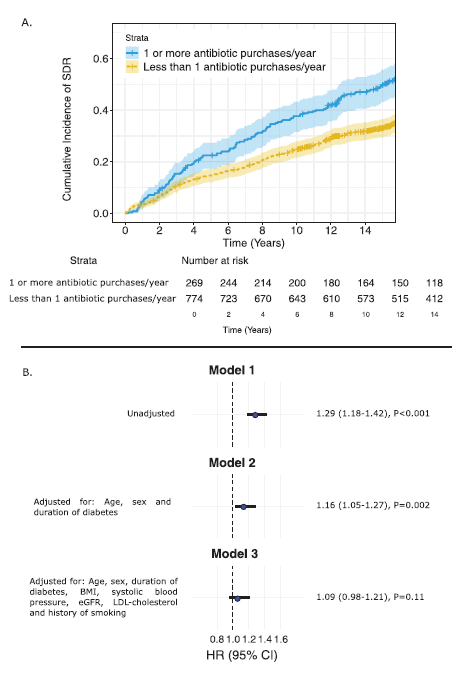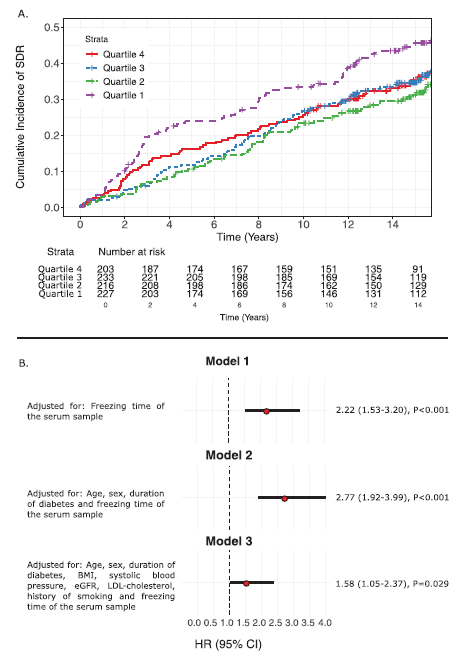Diabetic retinopathy, or diabetic eye disease, shares many risk factors with other diabetic complications, including general inflammation. Bacterial infections are potent inducers of inflammation and have been associated with the development of many diabetic complications. A new study, conducted by the FinnDiane group at Folkhälsan Research Center, found a clear association between bacterial infections and the development of diabetic retinopathy.
Diabetic retinopathy is a condition where the retina in the eyes is damaged as a consequence of diabetes. Diabetes distorts the blood flow in the small blood vessels in the eyes, causing blockades and bleeding of the blood vessels. In addition, a feared consequence of diabetic retinopathy is the formation of new fragile blood vessels, called neovascularisation. These new blood vessels can easily break and bleed into the eye, lowering the vision of the individual, which untreated can cause blindness. Diabetic retinopathy may also cause swelling in the macula, which is the area necessary for acute vision, therefore also lowering the vision.
Rasmus Simonsen, main author of this research, is studying the effect of bacterial infections on chronic diabetic complications and genetic factors behind susceptibility to infections in diabetes. Simonsen graduated from the University of Helsinki Medicinal Faculty in 2016 and has been specializing in anesthesiology and intensive care. Now, he is continuing his career as a researcher and PhD-student in the FinnDiane Study Group.
– Inflammation has been thought to play a role in practically all diabetic complications, including diabetic kidney disease and cardiovascular disease. Infections are involved as they cause major inflammatory reactions and have been associated with similar diseases in the general population, but the association between infections and chronic diabetic complications is far from established. Since infections are very common in diabetes and the complications are the major drivers of mortality and morbidity in individuals with diabetes, this field has been very interesting to investigate, says Simonsen.

Diabetic retinopathy is the most common diabetic complication as well as the leading cause of vision loss in working age individuals. The longer a person has had diabetes the higher their risk is for developing the disease. Furthermore, diabetic retinopathy is strongly associated with many other diabetic complications, for example, diabetic kidney disease. Both diabetic kidney disease and diabetic retinopathy are associated with macrovascular complications, which in turn increase the risk of cardiovascular morbidity, including strokes and heart attacks.
Thankfully, there are effective treatments available for reducing vision loss caused by diabetic eye disease. Even though these treatments are mostly successful, they do not cure diabetic retinopathy. This emphasises the importance of prevention and early diagnosis.
To date, several studies have shown that inflammatory processes facilitate the development of diabetic retinopathy. Experiments have demonstrated that inflammation causes leukocytes to gather around and stick to the cells within the retina, which is assumed to be one of the key processes in the development of diabetic retinopathy. Also, individuals with diabetic retinopathy usually have higher levels of inflammatory markers in their eye tissues compared to people without diabetes.
– Although the link and exact mechanisms between inflammation and diabetic retinopathy is yet unclear, research demonstrate a robust association between the two, says Simonsen.
Bacterial infections are potent inducers of inflammation. They are assumed to play a central role in the development of macrovascular disease as inflammation facilitates atherosclerosis. Furthermore, infections are also associated with microvascular disease, which is a common cause for acute kidney injury. Previous studies have found that the number of bacterial infections correlate with both development and progression of diabetic kidney disease and cardiovascular disease in individuals with type 2 diabetes.
Furthermore, increased levels of bacterial lipopolysaccharides are also associated with development and progression of diabetic kidney disease and cardiovascular disease. Bacterial lipopolysaccharides are membrane components, or endotoxins, of bacteria that end up in the circulation from different sites.
– Bacterial lipopolysaccharides, or LPS, come from the outer layer of gram-negative bacteria. They reach the blood circulation through different ways, particularly from the gut and the oral cavity, but they have been generally thought to reach the blood during infections with gram-negative bacteria as well. LPS is measured from blood samples with a special assay.
As diabetic eye disease shares many risk factors with other diabetic complications and bacterial infections and inflammation seem to play central roles in the development of many of these vascular complications, the hypothesis that inflammation and bacterial infections may be associated with diabetic eye disease as well is plausible.
This study analysed a large sample of individuals with type 1 diabetes to compare the incidence of diabetic retinopathy with data on bacterial infections. The study used two separate measurements to determine the association of diabetic eye disease and bacterial infections.
Firstly, an analysis of the association of antibiotic purchases and diabetic retinopathy was conducted, antibiotic purchases being an indicator of the individual having a bacterial infection that needs to be treated.
Individuals with frequent antibiotic purchases had a greater cumulative incident of severe diabetic retinopathy compared to individuals with infrequen purchases and the antibiotic purchases were found to be a significant statistic risk factor for severe diabetic retinopathy. When the risk was more closely assessed, it was still a significant risk factor for severe diabetic retinopathy when factoring in age, sex and the duration of diabetes. However, when all risk factors were considered this risk factor was statistically only borderline-significant.

Secondly, the association of bacterial lipopolysaccharides and diabetic eye disease was assessed in the same manner. High lipopolysaccharide concentrations were significantly associated with an increased risk for incident diabetic eye disease with all factors considered.

– Essentially, what we saw in our study, Simonsen explains, was that bacterial infections and LPS were associated with the development of severe diabetic retinopathy, which was a novel finding. Although we can only speculate as to the exact mechanisms, with this study we further underline how infections and diabetic complications are linked to each other. Although this study won’t directly impact the treatment of diabetic retinopathy, it will open the door for future studies and raises questions about how diabetic retinopathy develops and how infections and inflammation play a role in it.
Diabetic retinopathy shares many risk factors with other diabetic complications, including general inflammation. In previous studies, bacterial infections have been associated with the development of many diabetic complications.
This study was able to explore the association of bacterial infections and endotoxins with diabetic retinopathy. The study demonstrates how both infections and high levels of lipopolysaccharides act as risk factors of severe diabetic retinopathy in individuals with type 1 diabetes.
However, this is a purely observational study. As such, causation cannot be implied, only association, and the mechanisms by which bacterial infections and endotoxins contribute to the development of diabetic nephropathy remain open for later studies to explore.
– There have been very few studies to assess the relationship between infections and diabetic retinopathy. Therefore, this work was needed. I’m really looking forward to all future research looking at the mechanisms between infections and the development of diabetic complications, Simonsen concludes.
Simon Granroth, Science Communicator
The whole study can be read in full text here.
References:
Simonsen JR, Järvinen A, Hietala K, et alBacterial infections as novel risk factors of severe diabetic retinopathy in individuals with type 1 diabetesBritish Journal of Ophthalmology Published Online First: 14 September 2020. doi: 10.1136/bjophthalmol-2020-316202
Reuse of all figures is allowed pursuant to the terms of the Creative Commons Attribution-NonCommercial 4.0 International (CC BY-NC 4.0) licence.
